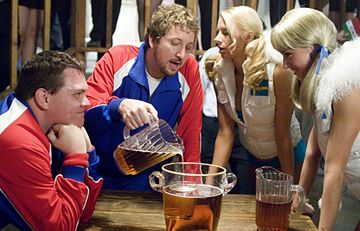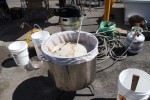 In the midst of the depressing heat of summer, I find myself looking more and more for beers I think of as “drinkable”. The problem is, I’m not even really sure what I mean by that word. Folks seem to have some disparate ideas about what it is to be “drinkable”. Anhueser-Busch pushed the term in association with their Budweiser line a few summers ago. I refuse, however, to purely equate the word with their product. Bud Light may very well be drinkable, but not all things drinkable are Bud Light. In the strictest sense, all beers are drinkable because you are able to drink them. That, however, gets us nowhere. So what could “drinkable” mean? I think the most satisfactory explanation I have found is that a beer is drinkable if you find yourself wanting another right after you have finished.
In the midst of the depressing heat of summer, I find myself looking more and more for beers I think of as “drinkable”. The problem is, I’m not even really sure what I mean by that word. Folks seem to have some disparate ideas about what it is to be “drinkable”. Anhueser-Busch pushed the term in association with their Budweiser line a few summers ago. I refuse, however, to purely equate the word with their product. Bud Light may very well be drinkable, but not all things drinkable are Bud Light. In the strictest sense, all beers are drinkable because you are able to drink them. That, however, gets us nowhere. So what could “drinkable” mean? I think the most satisfactory explanation I have found is that a beer is drinkable if you find yourself wanting another right after you have finished.
Adequately subjective but still provides the guidance we need to have a meaningful discussion, so let’s stick with it for the purpose of this article.
Some styles are, by their nature, more inclined toward drinkability than others. I would venture to say that there are more drinkable American lagers than there are drinkable English barleywines. I love English barleywines, but I rarely find myself wanting to pound them in sequence, especially in the summer. Rather than simply placing broad categories of beer in or out of the definition, though, let’s try to break down some of the particular features of a beer than contribute to or detract from a beer’s drinkability and touch on what a brewer can do to enhance drinkability. That isn’t always the goal, especially in today’s American craft scene, but it’s nice to have the tools when that particular job is at hand.
The three features that strike me as most important in assessing a beer’s drinkability are acidity, dryness, and balance. Acidity is perhaps the most important feature in a drinkable beer. Simply put, a slightly depressed pH will enhance the drinkability of a beer. There are two main reasons that this is true. The first is that acidity itself serves as a palate cleanser and a thirst quencher. Mild acidity can assist in the removal of persistent flavors and the suppression of thirst sensations by stimulating the production of saliva during the act of drinking. This leaves you with less “aftertaste” and a greater sensation of quenching. The second reason acidity enhances drinkability is its psychological association with refreshment. If you started making a list of things you regard as refreshing, chances are high that most of those things would be acidic. Citrus, fruit juice, lemonade, soda. Even cool water is more refreshing, in part, because lower temperatures encourage the presence of CO2 in solution, which creates carbonic acid and slightly lowers the pH.
This brings us to the practical application. How can you effectively boost acidity in a beer? There are plenty of ways this can be done. Not all will be appropriate in a given situation, but some will. One way to boost acidity is to simply utilize more acidic water in the process. Calculated additions of food grade lactic acid can not only boost mash efficiency but also enhance drinkability of the final product. Darker malts will also increase the acidity of your wort and final product. The addition of acidic ingredients, such as citrus, fruits, or coffee can clearly make your beer more acidic as can the use of souring microorganisms, which can produce a variety of pH-lowering acids during their metabolism. As discussed above, a higher degree of carbonation can also do a great deal for a beer’s acidity and drinkability.
Dryness is also an important characteristic of a drinkable beer. By dryness I, of course, mean a high level of attenuation causing the residual sugars to be low compared to the starting level of sugars. While actual ethanol is very nearly neutral on the pH scale, the high level of attenuation removes excess sweetness, which the palate interprets as the least quenching or refreshing flavor category. Dryness can create perceptions of “clean” or “crisp” flavors, which can enhance the drinkability of a beer. A brewer can make a beer drier by mashing in at lower temperatures to encourage the formation of more highly fermentable sugars, can purposefully add highly fermentable adjuncts such as dextrose, and can take care of yeast well enough that they do all of the job asked of them.
The final feature of a drinkable beer we will be tackling today, balance, is perhaps the hardest to define and easiest to identify. It is fairly easy to take a swig of a beer and immediately determine if it is in balance or if there is some aspect of the flavor that overshadows all the others. There is nothing wrong with assertive flavors, but they do create opportunities for a palate to tire and want something different. The most drinkable beer has plenty of good flavors but maintains a balance between them in order to keep the drinker reaching for another. The bitterness has to be in balance with the residual sweetness from the malt. The flavor additives have to blend well with the flavors present in the malt, hops, and yeast. Each note should be evident without being overly assertive. These balances tend to be more difficult to achieve at the extreme ends of alcoholic strength and easier to achieve with a more moderate alcohol range, but erring on the side of lower alcohol tends to simplify things by leaving fewer potential error options. Unfortunately the practical application of balance is not something easily encapsulated in a nugget of advice. Sure there are target ratios to achieve and style guidelines to stick to, but nothing beats actually brewing. Brew often and pay attention to what you are doing, and the ability to balance your brews will come.
Hopefully everyone feels a little better equipped to deal with drinkability now. Until next time, faithful readers, thanks for reading, and happy drinks!
P.S. Remember to let me know if you have some specific topic you would like me to babble about next time. You can tell me in person, by e-mail, or in the comments right down below.





